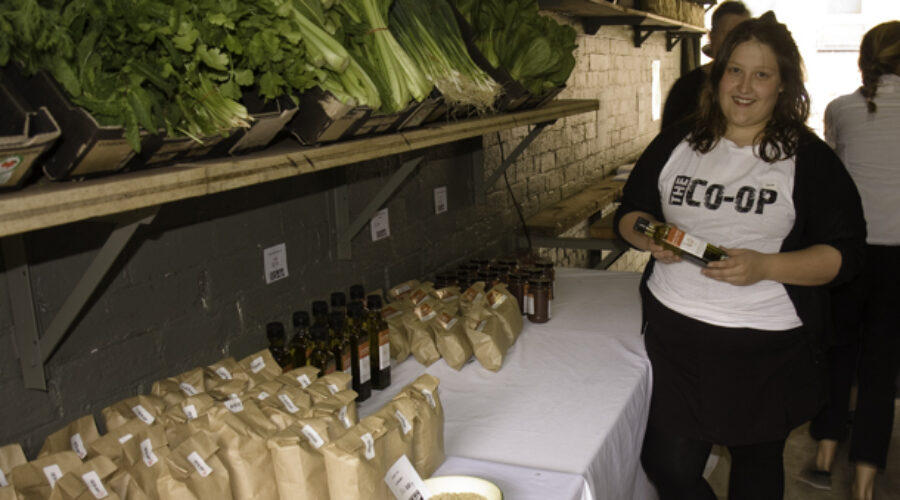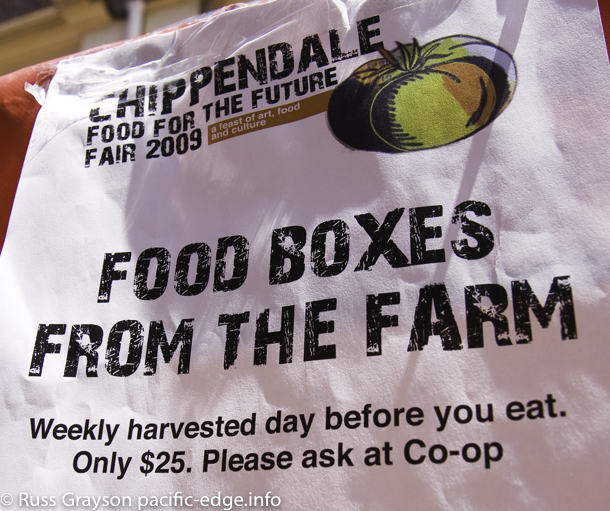Building the alt.food food system
Our food futures…
What follows is the content of the handout for the community food systems session at Australasian Permaculture Convergence 13 in Perth, Western Australia in early October 2016. The session was led by Fiona Campbell and I.
IN THIS SESSION AT APC13 we want to delve into the emerging fair food or alternative food supply chain — the path that food follows from farmer, through food processor, to distributor to eater.
Fair food is food produced and distributed in ways that are regenerative of natural resources, provide a viable income to the farmer, economic and employment opportunity to food producers and distributors and that deliver affordable, quality food to eaters.
The alternative food supply chain, as the fair food supply chain is also known, is so-called because it offers choice in the way we obtain what we eat and, where it is available, offers an alternative to the big, industrial food chain dominated by a small number of corporations.
A structured assessment
The strategic questioning methodology known as ORID is a way we can approach our thinking about the fair food supply chain in a structured way.
ORID follows a sequential path through a set of four types of questions:
O — Objective: what do we know?
R — Reflective: What do we think of it?
I — Interpretive: what does it mean?
D — Decisional: what do we do about it?
Here are our ORID questions we can follow in our APC13 session…
- who makes up the community food movement? What organisations?
- what issues do they address?
- what has been working well in the movement over the past ten years?
- what have been some of the changes within the fair food movement?
- what would it take to create a more successful Australian community food movement?
- what part do we all play in building this community food movement?
- what is the next step?
The structure of the alt.food system
We can imagine fair food organisations occupying points on a continuum.
- at one end are the small-scale farmers and the urban organisations engaging directly with food production — the new city farm enterprises we see in Hobart, Adelaide and Canberra and Sydney, as well as the voluntary sector community food production initiatives like community gardens
- at centre point of our continuum are the aggregator-distributors, agencies like Brisbane Food Connect, Sydney’s Ooooby and Organic Food Buyers, Melbourne’s CERES Fair Food and regional CSAs (Community Supported Agriculture); these are the link between farmers and the people who buy what the farmers produce; they aggregate the produce of many farmers and distribute it to urban buyers; in big cities, these aggregator-distributors, sometimes called ‘hybrid CSAs’, have proven a more effective type of connection between farmer and eater than the direct farmer-to-eater model
- at the other end of the continuum are the national food advocacy organisations like the Right To Food Coalition.
The food advocacy organisations create the political and economic space in which fair food producers, processors and distributors can flourish. By advocating supportive government policy, by defending the small commercial and community growers and the new food distribution systems from bad government policy and industry actions, the advocacies develop and defend the freedom and operating space for fair food farmers and food distributors to grow in.
Australia’s food advocacy organisations
What are the main national political advocacies in Australia?
Right To Food Coalition: A broad coalition with focus on food security and nutritional health.
Food Connect Foundation: Brisbane-based, the Foundation supports the development of a resilient food culture and the organisations involved in it; the Foundation is connected to Brisbane Food Connect, the city’s major food hub developing the alternative food supply chain.
Youth Food Movement (YFM): For people to 35 years of age, YFM’s mission is to engage young people in food issues; their focus is largely educational
Australian City Farms & Community Gardens Network: networks, maps, advises and advocates for community sector urban agricultural initiatives
Sustain — Melbourne-based entity describing itself as a ‘meta food network’ connecting other fair-food-focused organisations and also engaged in educational work.
Australian Food Sovereignty Alliance: A focus on food sovereignty — the right to choose the foods that eaters prefer and for farmers to produce food in ways they prefer. AFSA has both a farming and urban food distribution focus and is presently accumulating funds to support farmers overburdened by regulation.
Regional food organisations
Regional food organisations supplement the work of the national advocacies and operate at the scale of cities and regions through a range of activities. These are just a few…
Open Food Network (OFN): A Melbourne-based social enterprise building the regional food economy by connecting people with food from ecologically, regeneratively-managed small, regional farms. Operating through the Open Food Foundation, OFN produces open source solutions that link eaters with food producers and distributors. OFN has produced open source software for food distributors and provides networking and educational services to people involved in alternative food distribution systems
Urban Agriculture Australia: An ACT- based group presently networking urban agriculture interests in the ACT and working on the Canberra City Farm proposal.
FEED: A peer-reviewed ecological farmer endorsement program
Lismore Urban Agriculture: Developing a culture of home food growing in the city
Byron Region Food Sovereignty Network: An advocacy and educational organisation around the rights of growers and eaters
Sprout Tasmania: Working with small-scale farmers to intervene in the food supply chain to make available quality food; an educational, advocacy and assistance focus
Urban Farming Tasmania: Growing and sharing ecologically-produced food and furthering agricultural biodiversity through seed saving and distribution.
Barriers
A barrier to the development of fair food in Australia is the supermarket duopoly of Coles and Woolworths. The economic strength of the duopoly has brought unfair pressures on farmers and Australian food processors and brings it control over 70-80 percent of Australia’s food and grocery market.
Controversies over supermarket industry treatment of Australian farmers has attracted public support for farmers. Building on this sympathy for farmers and Australian food processing industries offers an avenue of action to fair food advocates to highlight the situation of small-scale Australian farmers, the food processing industry and the quality and affordability of food offered to eaters.
Structures for moving forward
The number of national and regional food production and advocacy organisations operating in the fair food space has grown since 2010. Now, the opportunity exists to establish a fair food system in Australia. Work has already started with recent food production initiatives and the emergence of fair food advocacy organisations. What needs to be done to make this movement stronger?
A strategy is needed and it could be formulated like this:
1. Intelligence
- What do we know about the scale, structure and direction of the fair food movement as it presently exists?
- What are the barriers the movement faces?
- What opportunities can be exploited?
2. Clear intent
The fair food movement has no clearly defined and stated focus agreed to my most or all food production, distribution, food processing and advocacy organisations.
Each organisation does its work, however communication and coordination between them could be improved.Developing a common program that organisations rally around could bring together the different organisations in the fair food movement.
3. Appropriate means
The means of enacting a common program would be the work of the different food advocacy organisations in their particular areas of operation and influence, combined into a single focus.
4. Clear plan of action
Any plan of action or common direction needs to be general so as to incorporate the different organisational structures, demographics and foci. It would probably be better not to develop even a generalised plan and agree instead on a common vector, a direction to follow. That avoids detailed planning, which can be left to the individual organisations.
All social movements require self-monitoring to assess that what they do is effective. Being effective means achieving what you set out to achieve. A means of doing this would be necessary for any social movement moving towards a common, overall goal of developing a fair food system.
A fair food movement is already being built in Australia. It can be strengthened through communication, cooperation and a common goal that brings focus. How that would be done could form the focus of a national conversation among fair food production, distribution and advocacy organisations.
………………………
Biographical note: Russ Grayson is a citizen journalist with experience in print, radio and online journalism and photojournalism. With others he taught the Permaculture Design Certificate in Sydney. He was a member of Sydney Food Fairness Alliance, a founding member of the Australian Food Sovereignty Alliance and has advised and worked for local government on policy directions for community food gardening and in the establishment of gardens. Russ has project managed food security and farmer training programs in the Solomon Islands.


